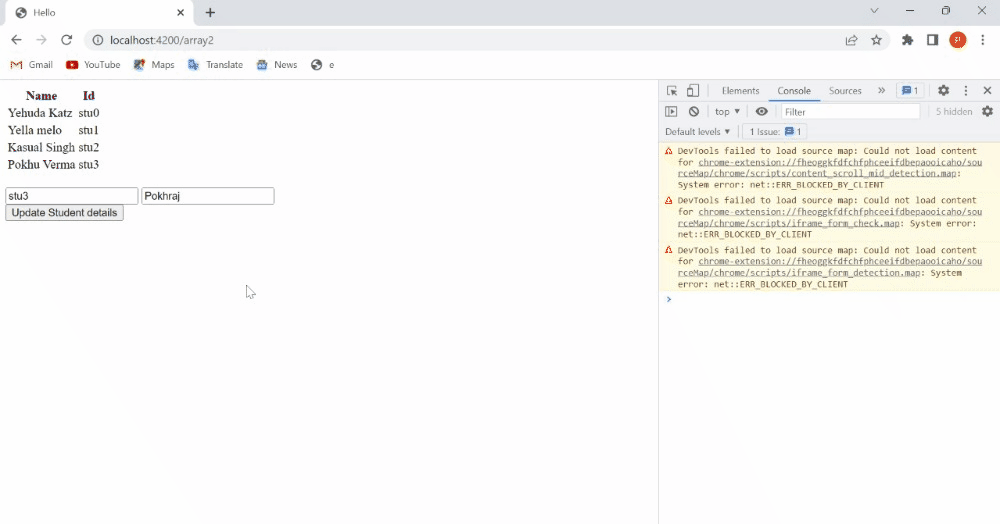Ember.js Controller actions Property
Last Updated :
15 Dec, 2022
Ember.js is an open-source JavaScript framework used for developing large client-side web applications which is based on Model-View-Controller (MVC) architecture. Ember.js is one of the most widely used front-end application frameworks. It is made to speed up development and increase productivity. Currently, it is utilized by a large number of websites, including Square, Discourse, Groupon, Linked In, Live Nation, Twitch, and Chipotle.
The action() method is used to create the function that will be invoked when a matching action is triggered from within templates and that application’s current route is this route.
Syntax:
action:{ // functions };
Parameters:
- functions: These are the functions that are invoked when a matching action will trigger from within templates.
Steps to Install and Run Ember.js:
Step 1: To run the following examples you will need to have an ember project with you. To create one, you will need to install ember-cli first. Write the below code in the terminal:
npm install ember-cli
Step 2: Now you can create the project by typing in the following piece of code:
ember new <project-name> --lang en
To start the server, type:
ember serve
Example 1: Type the following code to generate the route for this example:
ember generate route action1
app/controllers/action1.js
Javascript
import Controller from '@ember/controller';
import { action, find } from '@ember/object';
import Ember from 'ember'
let Student = Ember.Object.extend({
firstName: null,
lastName: null,
fullName: Ember.computed('firstName', 'lastName', function () {
return `${this.get('firstName')} ${this.get('lastName')}`;
}),
Changed: Ember.observer('fullName', function () {
console.log(`fullName changed to: ${this.get('fullName')}`);
})
});
export default class Array2Controller extends Controller {
stu2 = Student.create({
firstName: 'Kasual',
lastName: 'Singh',
Id: 'stu2'
});
stu0 = Student.create({
firstName: 'Yehuda',
lastName: 'Katz',
Id: 'stu0'
});
stu1 = Student.create({
firstName: 'Yella',
lastName: 'melo',
Id: 'stu1'
});
stu3 = Student.create({
firstName: 'Pokhu',
lastName: 'Verma',
Id: 'stu3'
});
value = this.stu3.get('Id');
students = [this.stu0, this.stu1, this.stu2, this.stu3]
@action
print(data1, data2) {
let ans = this.students.findBy('Id', data1)
ans.set('firstName', data2)
}
}
|
app/templates/action1.hbs
HTML
<table>
<tr>
<th>Name</th>
<th>Id</th>
</tr>
{{#each this.students as |detail|}}
<tr>
<td>{{detail.fullName}}</td>
<td>{{get detail "Id"}}</td>
</tr>
{{/each}}
</table>
<br />
{{input value=this.value}}
{{input value=this.value2}}
<br />
<input
type="button"
id="set-code"
value="Update Student details"
{{action "print" this.value this.value2}}
/>
|
Output:

Ember.js Controller actions Property
Example 2: Type the following code to generate the route for this example:
ember generate route action2
app/routes/action2.js
Javascript
import Route from '@ember/routing/route';
export default class StudentsRoute extends Route {
p1 = [
'Digital Camera',
'Jugs, cups & straws',
'Balloons',
'Scissors',
'Cold Drink',
'Table',
];
model() {
return this.p1;
}
setupController(controller, model) {
super.setupController(controller, model);
controller.set('p1', this.p1);
}
}
|
app/controllers/action2.js
Javascript
import Ember from 'ember';
export default Ember.Controller.extend({
value: 'value',
init() {
this._super(...arguments);
this.addObserver('value', this, 'Change');
},
Change() {
console.log('value changed');
},
actions: {
remove(data) {
this.p1.set('[]', this.p1.without(data));
},
print() {
let ans = this.p1.set('[]');
alert(ans.join('\n'))
},
},
});
|
app/templates/action2.hbs
HTML
<ul>
<h3>List is : </h3>
{{#each @model as |party|}}
<li>{{party}}</li>
{{/each}}
</ul>
<br />
{{input value=this.value}}
<br/>
<input
type="button"
id="check-atIndex"
value="Remove"
{{action 'remove' this.value}}
/>
<br/><br/>
<input
type="button"
id="print-item"
value="Print All Items"
{{action 'print' this.value}}
/>
|
Output:

Ember.js Controller actions Property
Reference: https://api.emberjs.com/ember/4.6/classes/Controller/properties/actions?anchor=actions
Share your thoughts in the comments
Please Login to comment...